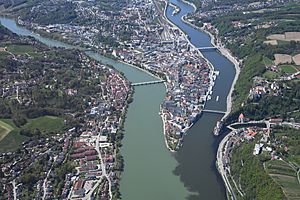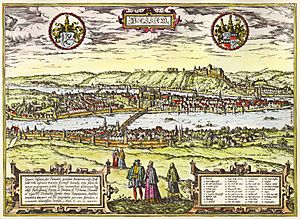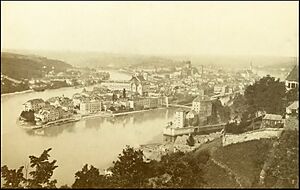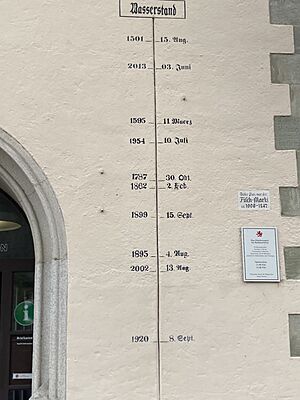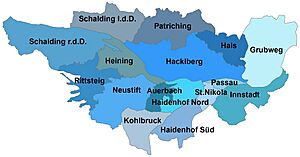Passau facts for kids
Quick facts for kids
Passau
|
|||
|---|---|---|---|

Donaulände and Old town
|
|||
|
|||
| Country | Germany | ||
| State | Bavaria | ||
| Admin. region | Niederbayern | ||
| District | Urban district | ||
| Elevation | 294-447 m (−1,172.5 ft) | ||
| Population
(2022-12-31)
|
|||
| • Total | 53,907 | ||
| Time zone | CET/CEST (UTC+1/+2) | ||
| Postal codes |
94001–94036
|
||
| Dialling codes | 0851 | ||
| Vehicle registration | PA | ||
| Website | www.passau.de | ||
Passau is a city in Lower Bavaria, Germany. It is often called the Dreiflüssestadt ("City of Three Rivers"). This is because the Danube river meets two other rivers here: the Inn from the south and the Ilz from the north.
Passau has about 50,000 people living there. Around 12,000 of them are students at the University of Passau. This university is well-known in Germany for its studies in economics, law, religion, computer science, and cultural topics.
Contents
History of Passau
Early Settlements and Roman Times
Around 200 BC, a group of people called the Boii tribe moved north across the Alps. They set up a new main city called Boiodurum. Today, this area is part of Passau's Innstadt district.
Later, Passau became an ancient Roman settlement named Batavis. This name means "for the Batavi." The Batavi were a Germanic tribe who often served in the Roman army. Batavis was a Roman fort in the area of Raetia. Another Roman fort, Boiotro, was in the area of Noricum.
Monasteries and Bishops
In the late 400s, St. Severinus started a monastery here. The area was often attacked by the Alemanni tribe. In 739, an English archbishop named Boniface started the diocese of Passau. For many years, this was the largest church area in the German Kingdom and Holy Roman Empire. It covered parts of southern Bavaria and most of what is now Upper and Lower Austria. From the 900s, the bishops of Passau also ruled the local area as Prince-Bishops.
A small Jewish community lived in Passau before World War II. Jews were first mentioned in the city as early as the 900s.
Important Treaties and Craftsmanship
The Peace of Passau was signed in 1552. In this agreement, Archduke Ferdinand I worked with the Protestant princes. They agreed to discuss religious issues at a special meeting. This meeting later led to the Peace of Augsburg in 1555.
During the Renaissance period, Passau was famous for making swords and other bladed weapons. Only Solingen made more. Smiths in Passau put a special wolf symbol on their blades. This wolf was a simpler version of the wolf on the city's coat-of-arms. Many warriors believed that the Passau wolf made the sword's owner unbeatable. Because of this, Passau swords were very valuable. Sometimes, other special symbols were added to the swords. This practice of adding charms to swords for protection became known as "Passau art." Smiths from other cities, like Solingen, started using the Passau wolf too. By the 1600s, Solingen was making more wolf-stamped blades than Passau.
Fires and Modern History
In 1662, a huge fire destroyed most of Passau. The city was then rebuilt in the beautiful Baroque style.
In 1803, Passau's church rule ended. The city was split between the Electorate of Bavaria and the Electorate of Salzburg. The part that belonged to Salzburg became part of Bavaria in 1805.
From 1892 to 1894, Adolf Hitler and his family lived in Passau.
During World War II, Passau had three smaller camps connected to the Mauthausen-Gusen concentration camp. From January to May 1945, people fleeing from East Prussia and Silesia passed through the city. After May, more people arrived in Passau. These were Germans who had to leave their homes in nearby Bohemia and Moravia.
On May 3, 1945, Passau officially surrendered to the American forces. After the war, Passau was a place where many people who had lost their homes found shelter.
On June 2, 2013, the old town of Passau had severe flooding. This happened after many days of rain and because the city is where three rivers meet. You can see the highest flood levels from as early as 1501 marked on a wall at the Old City Hall. Floodwaters usually reach the base of that wall about once every five years.
City Areas
Until 2013, Passau was divided into eight main areas. These areas were usually old towns that had joined Passau. Since 2013, the city has 16 "areas of open council" (German: Bürgerversammlungsgebiete).
Main Sights in Passau
Many river cruises on the Danube river start in Passau. There is also a cycling path that goes all the way to Vienna. Passau is part of a special heritage route called the Route of Emperors and Kings.
Passau is famous for its Gothic and baroque architecture. The city is overlooked by the Veste Oberhaus and the Veste Niederhaus. These were once parts of the bishop's fortress. They sit on the hill between the Danube and Ilz rivers.
Visitors to Passau mostly enjoy the three rivers, the St. Stephen's Cathedral (German: Der Passauer Stephansdom), and the "Old City" (Die Altstadt).
The organ at St. Stephen's Cathedral is very impressive. It has 17,774 pipes and 233 stops! For a long time, it was the biggest church pipe organ in the world. Today, it is the second largest. Organ concerts are held daily from May to September. St. Stephen's is a beautiful example of Italian Baroque style. It was built by Italian architect Carlo Lurago and decorated by Carpoforo Tencalla.
Other churches include the Jesuits church of St. Michael, the old parish church of St. Paul, and the Mariahilf pilgrim church. Mariahilf is on the hill south of the Inn and Danube rivers.
In front of the cathedral is a large square called Domplatz. Here you can find the Lamberg-Palais, where the Peace of Passau was signed. The medieval Old Residence and the baroque New Residence were palaces where the Prince-Bishops lived. Next to the 14th-century Gothic city hall is the Scharfrichterhaus. This is a well-known place for jazz music and comedy shows.
Image gallery
Helping People in Need
Because Passau is located on the border between Germany and Austria, it has become a place where many people seeking safety arrive in Germany. These people, often from the Middle East, Asia, and Africa, travel through Europe. They sometimes walk into Passau, which is the first German town they reach. This situation has led the city of Passau to use money that was planned for flood protection to help house and feed these people. About 10% of them are children traveling alone.
Sister Cities
Passau has special friendships with other cities around the world. These are called "twin towns" or "sister cities":
 Hackensack, United States (1952)
Hackensack, United States (1952) Cagnes-sur-Mer, France (1973)
Cagnes-sur-Mer, France (1973) Krems an der Donau, Austria (1974)
Krems an der Donau, Austria (1974) Akita, Japan (1984)
Akita, Japan (1984) Málaga, Spain (1987)
Málaga, Spain (1987) České Budějovice, Czech Republic (1993)
České Budějovice, Czech Republic (1993) Liuzhou, China (1999)
Liuzhou, China (1999) Veszprém, Hungary (1999)
Veszprém, Hungary (1999) Montecchio Maggiore, Italy (2003)
Montecchio Maggiore, Italy (2003)
Famous People from Passau
Many notable people have connections to Passau:
- Otto of Passau (died after 1383/86), a writer for the church
- Gottlieb Muffat (1690–1770), an organist and composer
- Joseph Ferdinand Damberger (1795–1859), a historian
- Joseph Maximilian von Maillinger (1820–1901), a general and war minister
- Hans Fruhstorfer (1866–1922), an explorer and expert on insects
- Georg Philipp Wörlen (1886–1954), a painter
- Christian Rub (1886–1956), an actor
- Adolf Hitler (1889−1945), lived here with his family from 1892–1894
- Henry Gerber (1892−1972), an early activist for gay rights in the U.S.
- Ludwig Schmidseder (1904–1971), a composer and pianist
- Albert Ganzenmüller (1905–1996), a politician
- Alfred Dick (1927–2005), a politician
- Nicolaus A. Huber (born 1939), a composer
- Heidi Schüller (born 1950), an athlete
- Bruno Jonas (born 1952), a comedian and actor
- Anna Rosmus (born 1960), an author and historian
- Andreas Seidl (born 1976), CEO of Sauber Motorsport
- Andreas Scheuer (born 1974), a politician
- Florian Silbereisen (born 1981), a singer and TV presenter
- Gisela Mashayekhi-Beer (born before 1983), an Austrian flute player
- Michael Ammermüller (born 1986), a race car driver
Climate
| Climate data for Passau (Fürstenzell) (1991–2020 normals) | |||||||||||||
|---|---|---|---|---|---|---|---|---|---|---|---|---|---|
| Month | Jan | Feb | Mar | Apr | May | Jun | Jul | Aug | Sep | Oct | Nov | Dec | Year |
| Mean daily maximum °C (°F) | 1.3 (34.3) |
3.8 (38.8) |
8.8 (47.8) |
14.7 (58.5) |
18.9 (66.0) |
22.5 (72.5) |
24.0 (75.2) |
23.8 (74.8) |
18.8 (65.8) |
13.0 (55.4) |
6.4 (43.5) |
2.3 (36.1) |
13.2 (55.8) |
| Daily mean °C (°F) | −1.2 (29.8) |
0.5 (32.9) |
4.5 (40.1) |
9.5 (49.1) |
13.8 (56.8) |
17.3 (63.1) |
18.6 (65.5) |
18.5 (65.3) |
13.9 (57.0) |
9.0 (48.2) |
3.6 (38.5) |
0.0 (32.0) |
9.0 (48.2) |
| Mean daily minimum °C (°F) | −3.7 (25.3) |
−2.6 (27.3) |
0.6 (33.1) |
4.5 (40.1) |
8.8 (47.8) |
12.3 (54.1) |
13.6 (56.5) |
13.5 (56.3) |
9.6 (49.3) |
5.5 (41.9) |
1.1 (34.0) |
−2.3 (27.9) |
5.1 (41.2) |
| Average precipitation mm (inches) | 66.5 (2.62) |
57.2 (2.25) |
69.5 (2.74) |
46.4 (1.83) |
93.6 (3.69) |
86.0 (3.39) |
111.0 (4.37) |
92.5 (3.64) |
71.8 (2.83) |
64.0 (2.52) |
56.4 (2.22) |
61.4 (2.42) |
872.4 (34.35) |
| Average precipitation days (≥ 1.0 mm) | 17.4 | 14.6 | 15.2 | 11.8 | 15.6 | 15.5 | 16.5 | 13.8 | 12.9 | 14.8 | 14.2 | 17.5 | 180.2 |
| Average snowy days (≥ 1.0 cm) | 18.2 | 14.7 | 6.8 | 0.2 | 0 | 0 | 0 | 0 | 0 | 0.1 | 3.9 | 11.4 | 55.3 |
| Average relative humidity (%) | 90.2 | 84.1 | 76.5 | 69.1 | 72.1 | 82.5 | 73.8 | 74.6 | 81.3 | 87.2 | 92.2 | 91.9 | 81.3 |
| Mean monthly sunshine hours | 57.0 | 92.9 | 148.4 | 205.5 | 223.8 | 242.8 | 241.6 | 236.6 | 176.1 | 116.0 | 58.3 | 49.2 | 1,846.5 |
| Source: World Meteorological Organization | |||||||||||||
See also
 In Spanish: Passau para niños
In Spanish: Passau para niños




